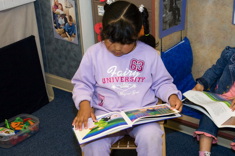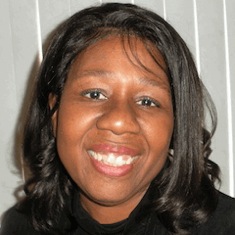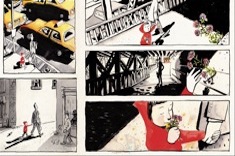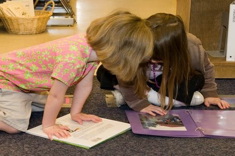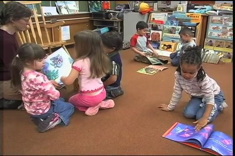Wordless picture books are a wonderful instructional tool for teachers to use with students of any age. I remember some time ago when the American Library Association annouched their annual awards, and we celebrated in our coaches’ meeting by giving each coach a copy of the Caldecott award-winning book Flotsam by David Wiesner. This was David Wiesner’s third Caldecott award, the second for a wordless picture book. After the ooh-ing and ah-ing, the coaches immediately began talking about how they planned to use the book.
Flotsam is a rather sophisticated wordless picture book. The story opens with a boy exploring on the beach. The boy finds a camera. After determining that the camera does not belong to anyone on the beach, he removes the film and has it developed. The pictures reveal intriguing and fantastic creatures and situations.
Sandy thought the book would be a wonderful tool to invite students to write a fantasy story to accompany the book illustrations.
Jim thought the book would be good to help students improve their understanding of story structure. He also planned to have students identify the character traits of the main character.
Patty thought the book would provide a great opportunity for oral language development. She planned to invite the students to orally tell the story that the illustrations present. She also planned to have the students record their version of the story and put the tape and book in classroom listening centers.
I quickly got caught up in their enthusiasm. I encouraged them to try their ideas in classrooms and report back at future coaches’ meetings. Here is what happened.
Fantasy Stories
Sandy’s fantasy stories were a rousing success. She presented her idea at the fifth and sixth grade level meetings. A couple of teachers invited her to try it in their classrooms. The fifth and sixth graders in those classrooms eagerly accepted the challenge of writing a fantasy story based on the illustrations in Flotsam. The writing workshops were dominated by stories of robot fish, reading octopi, giant starfish, and underwater aliens. There were group collaboration stories and individual efforts. Some students chose to extend the story by telling the tale of the next child who finds the camera.
A student came into class one day with a copy of Tuesday, David Wiesner’s other Caldecott winning wordless picture book. The frenzy started anew. Students started churning out tales of flying frogs. It didn’t take students long to discover that David Wiesner had “written” other wordless picture books, including another book with a science fiction/fantasy bent. They were off in search of Sector 7
. They stampeded the school library and commandeered all of the David Wiesner books available. Some students even ventured out to the public library.
Coaching opportunities for Sandy included supporting revision in the writing workshop. She supported teachers as they helped their students “show not tell” and refine their word choices. For almost all of the students, writing to accompany existing illustrations was new territory. Their text needed to fill in the details that were missing in Wiesner’s elaborate illustrations. Sandy suggested that the students examine some of Wiesner’s picture books with text included to see how their mentor matched text and illustrations. The students found examples of “show not tell” and made a list of Wiesner’s interesting word choices. They revisited their own versions of story to see how choosing just the right word could improve their stories. Sandy reported that it was one of those rare times when students didn’t resist revising.
Taking a Close Look at Story Structure
Jim had no difficulty finding teachers who were interested in working with their students on improving their understanding of story structure and characters. He wanted to work with the students in second and third grade. These students were at the stage where they were moving away from stories that featured a straightforward “beginning, middle, end” structure. Jim noticed that as the students’ reading choices became more sophisticated, some of them were becoming bogged down by the structure of a story. Jim believed that the students would benefit from some explicit instruction before their reading choices became really challenging. Jim remembered a group of sixth graders that had had a terrible time getting through Walk Two Moons (Creech,1996). They had never seemed to know where the characters were, what they were doing, or how they got there! Flotsam
includes some flashback and foreshadowing features. Jim was also interested in having the second and third graders look at the character traits of the main character.
Jim’s first lessons focused on the character. He projected the book on a screen using a document camera. First, Jim and the students simply walked through (and talked through) the book. The students were delighted by the book. On the second viewing, Jim asked the students to look at the character closely and think about what kind of person he is. The students noticed that he was “rich.” The character was at the beach with all kinds of expensive equipment (binoculars, magnifying glass, snorkel, microscope, etc.) When he discovered the film in the camera, he ran right out to the one-hour film processor-which one child pointed out “cost a lot more money.” The children also pointed out that the character was independent. He played alone on the beach. He wandered away from his parents at the beach, and they didn’t call him back. He even left the beach, went to the film processor alone, and waited outside of the store until the pictures were ready. The boy didn’t show the interesting pictures to his parents. He also didn’t consult anyone when he decided to throw the camera back into the water.
The final descriptor for the boy was “cooperative.” The children pointed out that there was an unspoken agreement that after you find the camera and enjoy the pictures, you should take a picture of yourself and throw it back into the water. The children decided that if the main character was selfish or uncooperative, he would have kept the “cool camera” for himself. He wanted more children to have as much fun as he had had, so he cooperated and threw the camera back into the water.
Jim was very pleased with the children’s analysis of the character. He moved on to the story structure. He posed the question, “Where does this story begin?” After some discussion and debate, they decided that the “reader” comes in towards the end of the story. The story had been going on since “the olden days.” Lots of children had had the camera before the main character found it. Jim asked, “Why did David Wiesner start his book toward the end?” The children quickly concluded that he started the story in “our time.” That reason made sense to Jim.
Oral Renditions of Wordless Picture Books
Initially, Patty did not experience the same level of success with Flotsam as her colleagues. She tried out the book in some primary and bilingual classrooms because she decided that it was a good place to do oral language development activities. Her first planned activity was to do a group-composed story.
Patty also shared the book using a document camera to project the pages onto a screen. As expected, the children were absolutely delighted by Wiesner’s illustrations. On the first “reading,” the children walked and talked through the book. Patty noticed that there were more questions than she anticipated. She found herself naming sea animals and equipment and explaining the purpose of the equipment and how it worked.
On the second reading, Patty went around the room asking one child at a time to supply the words to go with the illustration projected on the screen. Patty was frustrated that the children did not use “story language.” There were no “once upon a times,” or “and suddenly he saws . . .” Some children simply supplied captions like “looking at bug ” instead of full sentences like, “The boy was looking at a bug.” The completed story turned out to be a collection of disjointed captions, phrases, and short sentences.
Patty was ready to throw in the towel on this project. She had a conversation with Sandy and heard about her students’ incredible fantasy stories. Sandy suggested that maybe the story was too sophisticated for kindergartners and ELL students. Maybe they haven’t developed the vocabulary or had the life experiences to tell such a story. Patty decided to try another book.
She selected the wordless picture book, School by Emily Arnold McCully. In this story, the youngest “mouse child” in the family is sad to be left at home after her older brothers and sisters go off to school. The mouse child decides to follow her siblings to school. She finds a seat in the classroom and isn’t discovered until she raises her hand to answer a question.
Patty immediately noticed the difference when the class did the first “reading” of the story. The children were caught up in the intrigue of the mouse child slipping away from her mother and finding her way to school. During the second reading, the children contributed several complete sentences for each page. One child even named the “mouse child” character. Before making the audio recording of the story, Patty talked to the children about the difference between “book language” and spoken language. She modeled how a sentence might sound if you were telling it to someone and how it would sound if you were reading it in a book.
After several practice runs, the kindergarten class made a delightful audio recording of School. They used a squeaky toy (simulating a mouse sound) for the “turn the page” signal. The class’ version of School
quickly became the most popular story at the listening centers. Patty decided that Sandy had made a good suggestion. The eventual success of the project depended on starting with a book based on experiences that were familiar to the children. Patty hasn’t completely given up on Flotsam
. She thinks that the children need more experience with the genre before she can expect them to create their own story.
All of the coaches agreed that Flotsam reminded them that wordless picture books are very valuable instructional tools. They are available in various levels of complexity and can be used in classrooms from kindergarten through middle school.

